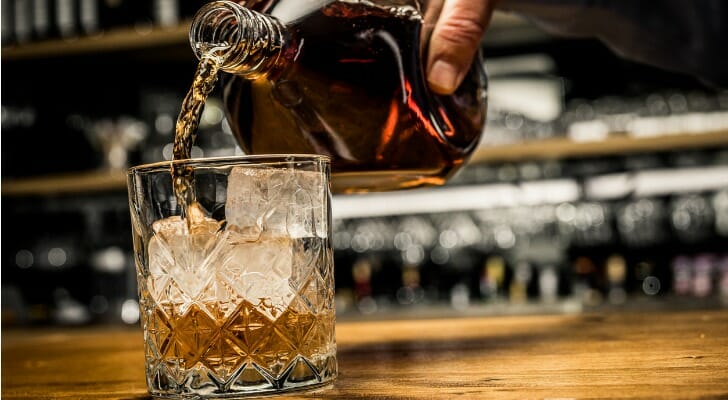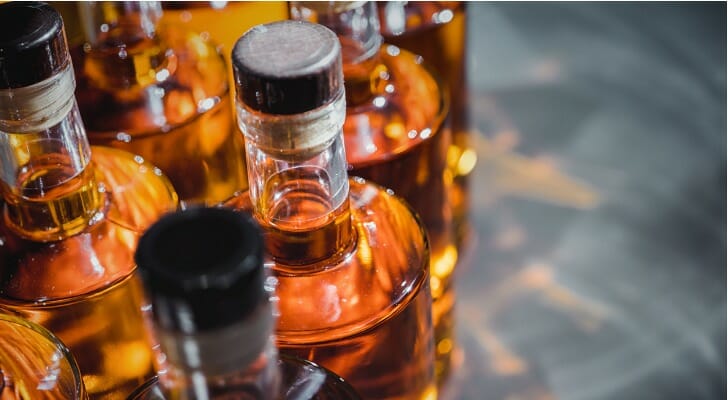Whiskey isn't just a beloved spirit and cultural institution. It can also be a profitable investment. Just like wine, the culture and market around whiskey have made it a valuable product. While common bottles aren't worth much, the right bottle can be worth hundreds, even thousands, of dollars. The U.S. industry as a whole is estimated to be worth around $11 billion, and is projected to reach between $16 billion and $18 billion over the next five years. Whiskey is an alternative investment that can appreciate in value. You can buy whisky both by the bottle and the cask. Here's what you need to know.
A financial advisor can help you decide whether alternative investments are right for you. Find an advisor today.
What Is Whiskey?
With any product or investment, it's worth learning exactly what you'll be buying into.
Whiskey is a spirit made from grains, typically rye, corn or barley. Spirits are a type of alcohol made by the distillation process, while alcohols like beer and wine are made through fermentation.
Distillation requires two steps. First, a base product like grain or fruit is fermented – a process in which organic sugars decompose into alcohol. The fermented liquid is separated into its alcoholic and nonalcoholic components.
With whiskey, grains typically ferment at around a 5% ratio. This means that after the fermentation process you have a liquid that is about 5% pure alcohol and 95% base liquid, generally water. Most whiskeys are around 40% alcohol, or "40 proof," so the distiller will separate the fermented liquid until they have a ratio of about 40% alcohol and 60% base liquid.
Like wine, whiskey is typically aged. This is usually done in wooden barrels and can last anywhere from months to decades. Some distillers use a chemical process to simulate the effects of aging, which is cheaper, but it produces inferior results and a lower-value product.
Whiskey gets its flavor from every step of this process, including the underlying grains used for fermentation and any ingredients added during the distillation process. Even the wooden barrel flavors the whiskey. It comes in many different forms, but the most common are bourbon, U.S. rye whiskey, Scotch whisky (not a typo, there is no "e" in Scotch whisky), and Irish whiskey.
Investing in Whiskey BottlesAs with most collectible commodities, the most common way to invest in whiskey is by purchasing bottles of it directly.
In this case, your approach is to buy one or more bottles of whiskey and hold them in the belief that they will appreciate in value. And this can work very well. Even at the local liquor store, bottles of whiskey can sell for hundreds, if not thousands of dollars. In fact, a bottle of Johnnie Walker Masters of Flavour was on sale for $24,000 in early 2023.
That's just the stuff available around the corner. Other bottles have sold at auction for prices upward of $6 million.
There are many reasons for this, but the two biggest determinants in the price of whiskey are culture and age. Like wine, whiskey has a strong attachment to history and place. People tell stories through these bottles and value them for their lineage. The reason why this works with whiskey and wine, and is generally not true for most alcohols, has to do in part with the people who drink it. Since whiskey is prized, rare bottles tend to have a rich and famous pedigree, which makes it so valuable.
This culture also has to do with the underlying alcohol.
Unlike many drinks, whiskey tends to get better with age, which has two effects. First, old bottles remain good. Over 80 years a bottle of whiskey might only get better, while beer or vodka would become an undrinkable curiosity. Second, this makes good whiskey a rare commodity. You can't just brew up a new batch of the very best bottles. Those bottles take decades to reach maturity, making them both expensive and difficult to produce.
Finally, whiskey is a global asset. Wealthy communities in every part of the world want this product, meaning that you have both a wide market in which to find valuable bottles and a strong market for sales.
However, as with all collectible commodities, investing in whiskey is an art rather than a science. You are buying into the story of a bottle and the individual tastes of consumers. To invest in this market you need to understand it. Learn about the history of whiskey as a whole, as well as individual bottles. Invest in bottles that are likely to hold their cultural value as well as their flavor. And be prepared to sit on your purchase for years, since it may take a long time for any given bottle to really appreciate in value.
In addition to buying individual bottles, you can also invest in whiskey by purchasing individual barrels (or "casks") from a distillery. Many distilleries accept investment this way, allowing people to buy barrels of whiskey as they're entering the aging process.
There are pros and cons to this approach.
The advantage to buying into a barrel is volume and opportunity. You get the chance to buy this product before it establishes its reputation. If a batch of whiskey will turn out particularly well, you can get in on the ground floor. This also lets you buy in bulk since a single barrel can hold approximately 500 bottles worth of whiskey.
But keep in mind that in every batch of whiskey, some barrels go bad. Others turn out fine but are nothing special. The distillery will also typically charge you for storage and bottling. After all, once you buy the barrel it's yours and they're just holding it for you. Finally, as with bottles, this is a long-term investment. For any kind of meaningfully good whiskey, you should expect to hold the barrel for at least two or three years.
This isn't to say barrel investment is a bad idea. This can be an excellent way to capitalize on the whiskey market in bulk. However it is a long-term, potentially risky investment, so make sure to thoroughly research every batch you buy.
Finally, as with all assets, you can invest in whiskey by buying into the market. This means you can invest in the companies that make or distribute whiskey rather than invest in the underlying product itself.
For example, you can invest in the company Brown Forman (BF). This is a huge manufacturer responsible for, among many other brands, Jack Daniels. Or there is Diageo (DEO), the company behind Johnnie Walker.
You can also diversify your risk by investing in funds. While uncommon, you can occasionally find ETFs and mutual funds that track the global spirits industry or whiskey itself. These are uncommon, but assets like the ETFMG Whiskey & Spirits ETF do sometimes crop up.
Investing in the whiskey market is a more stable, if potentially less fun, way to add this asset to your portfolio. It will let you buy into the performance of the market as a whole, and will protect you against the inherent risk of investing in any collectible asset.
The Bottom LineInvesting in whiskey is more art than science. But whether you buy bottles, barrels or stocks, whiskey can be a profitable sector. Just remember that whiskey gets better with age, making it a potential long-term investment that you should expect to hold.
- Whiskey is what's known as an alternative investment. These can be interesting, fun, and under the right circumstances, profitable. A financial advisor can help you determine whether alternative assets are right for your portfolio. SmartAsset's free tool matches you with up to three vetted financial advisors who serve your area, and you can interview your advisor matches at no cost to decide which one is right for you. If you're ready to find an advisor who can help you achieve your financial goals, get started now.
- There are different platforms that allow you to invest in alternative assets, including real estate, art and antiquities. Here's a look at some of the top companies that you can use to add alternative investment exposure to your portfolio.
Photo credit: ©iStock.com/vm, ©iStock.com/imaginima, ©iStock.com/imaginima
The post How to Invest in Whiskey appeared first on SmartAsset Blog.
The views and opinions expressed herein are the views and opinions of the author and do not necessarily reflect those of Nasdaq, Inc.





